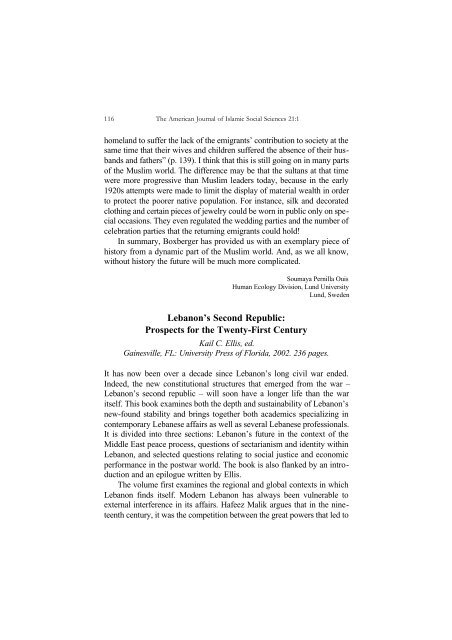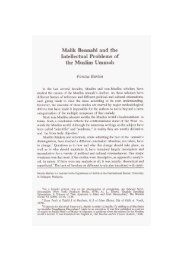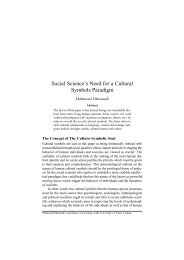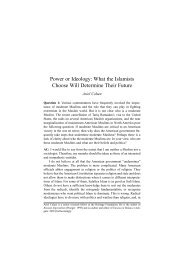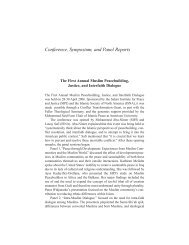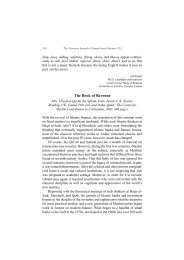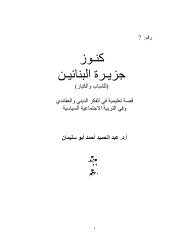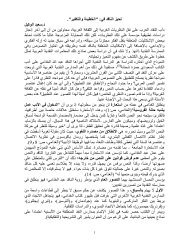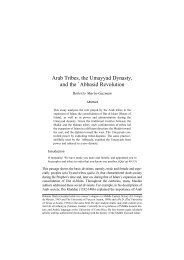Lebanon's Second Republic: Prospects for the ... - I-Epistemology
Lebanon's Second Republic: Prospects for the ... - I-Epistemology
Lebanon's Second Republic: Prospects for the ... - I-Epistemology
Create successful ePaper yourself
Turn your PDF publications into a flip-book with our unique Google optimized e-Paper software.
116 The American Journal of Islamic Social Sciences 21:1<br />
homeland to suffer <strong>the</strong> lack of <strong>the</strong> emigrants’ contribution to society at <strong>the</strong><br />
same time that <strong>the</strong>ir wives and children suffered <strong>the</strong> absence of <strong>the</strong>ir husbands<br />
and fa<strong>the</strong>rs” (p. 139). I think that this is still going on in many parts<br />
of <strong>the</strong> Muslim world. The difference may be that <strong>the</strong> sultans at that time<br />
were more progressive than Muslim leaders today, because in <strong>the</strong> early<br />
1920s attempts were made to limit <strong>the</strong> display of material wealth in order<br />
to protect <strong>the</strong> poorer native population. For instance, silk and decorated<br />
clothing and certain pieces of jewelry could be worn in public only on special<br />
occasions. They even regulated <strong>the</strong> wedding parties and <strong>the</strong> number of<br />
celebration parties that <strong>the</strong> returning emigrants could hold!<br />
In summary, Boxberger has provided us with an exemplary piece of<br />
history from a dynamic part of <strong>the</strong> Muslim world. And, as we all know,<br />
without history <strong>the</strong> future will be much more complicated.<br />
Soumaya Pernilla Ouis<br />
Human Ecology Division, Lund University<br />
Lund, Sweden<br />
Lebanon’s <strong>Second</strong> <strong>Republic</strong>:<br />
<strong>Prospects</strong> <strong>for</strong> <strong>the</strong> Twenty-First Century<br />
Kail C. Ellis, ed.<br />
Gainesville, FL: University Press of Florida, 2002. 236 pages.<br />
It has now been over a decade since Lebanon’s long civil war ended.<br />
Indeed, <strong>the</strong> new constitutional structures that emerged from <strong>the</strong> war –<br />
Lebanon’s second republic – will soon have a longer life than <strong>the</strong> war<br />
itself. This book examines both <strong>the</strong> depth and sustainability of Lebanon’s<br />
new-found stability and brings toge<strong>the</strong>r both academics specializing in<br />
contemporary Lebanese affairs as well as several Lebanese professionals.<br />
It is divided into three sections: Lebanon’s future in <strong>the</strong> context of <strong>the</strong><br />
Middle East peace process, questions of sectarianism and identity within<br />
Lebanon, and selected questions relating to social justice and economic<br />
per<strong>for</strong>mance in <strong>the</strong> postwar world. The book is also flanked by an introduction<br />
and an epilogue written by Ellis.<br />
The volume first examines <strong>the</strong> regional and global contexts in which<br />
Lebanon finds itself. Modern Lebanon has always been vulnerable to<br />
external interference in its affairs. Hafeez Malik argues that in <strong>the</strong> nineteenth<br />
century, it was <strong>the</strong> competition between <strong>the</strong> great powers that led to
Book Reviews 117<br />
<strong>the</strong> creation of Lebanon’s religiously based sectarian political system,<br />
which was a departure from <strong>the</strong> longstanding reliance on tribal networks<br />
as a way of structuring political life. In <strong>the</strong> twentieth century, paralleling<br />
this global competition <strong>for</strong> power, now articulated through cold war logic,<br />
was <strong>the</strong> emergence of fierce competition <strong>for</strong> regional hegemony between<br />
Nasserism, Palestinian nationalism, and Israeli irredentism, all of which<br />
penetrated, destabilized, and eventually contributed to <strong>the</strong> breakdown of<br />
<strong>the</strong> Lebanese polity.<br />
This book clearly states that today, <strong>the</strong>se destabilizing regional and<br />
global influences have subsided <strong>for</strong> <strong>the</strong> time being and have been replaced<br />
by American acquiescence to Syrian hegemony over Lebanese affairs. In an<br />
interesting article on Israeli-Lebanese relations, Kirsten Schulze adds Israel<br />
to <strong>the</strong> list of powers acquiescing to this geo-strategic situation, having, in<br />
effect, abandoned any larger projects aimed at fostering <strong>the</strong> creation of a<br />
Christian ministate to its north. As Ellis stresses, however, Lebanon’s resultant<br />
stability remains grounded in uncertainty, since it is a hostage to<br />
progress in <strong>the</strong> region’s overall peace process.<br />
The second part focuses on Lebanon’s cultural and religious heritage.<br />
The contributors argue that sectarian identities have become more<br />
entrenched in <strong>the</strong> postwar world. Paul Nabil Sayyah’s article explains this<br />
phenomenon with respect to <strong>the</strong> increasing challenges faced by traditional<br />
elites, as well as <strong>the</strong> underlying social patterns of coexistence between religious<br />
communities, from such new religious movements as Hizballah,<br />
which are questioning Lebanon’s “pacted” system of power-sharing. Fur<strong>the</strong>r<br />
contributing to this predicament, argues Nabeel Haidar, is Lebanon’s educational<br />
system, which has largely failed to <strong>for</strong>ge a strong sense of Lebanese,<br />
as opposed to communal, identity. Thus, <strong>the</strong> people continue to view <strong>the</strong>ir<br />
particular religious leader as <strong>the</strong>ir “political mediator” instead of looking to<br />
<strong>the</strong> state.<br />
Perhaps <strong>the</strong> most pointed example of <strong>the</strong>se hardening communal barriers<br />
is found in Julie Peteet’s excellent article on <strong>the</strong> Palestinian community<br />
in Lebanon. Highlighting a new war and a postwar process of “o<strong>the</strong>ring,”<br />
she argues that Palestinian relations with <strong>the</strong> Lebanese have become more<br />
socially and spatially polarized, a development that has reversed a more<br />
blurred prewar reality. Camp borders are now “brutally” defined and <strong>the</strong><br />
extent of Palestinian working rights have been increasingly restricted, both<br />
of which have contributed to a dramatic deterioration in <strong>the</strong> community’s<br />
socioeconomic well-being. Mona Khalaf’s article on <strong>the</strong> status of women<br />
in postwar Lebanon paints a similar picture of marginalization, character-
118 The American Journal of Islamic Social Sciences 21:1<br />
ized both by <strong>the</strong> “feminization of poverty” as well as by <strong>the</strong> entrenchment<br />
of legal discrimination, symbolized by <strong>the</strong> difficulties in re<strong>for</strong>ming<br />
Lebanon’s religiously controlled personal status laws and courts.<br />
The third section deals with a variety of socioeconomic problems.<br />
Wassim Shahin’s article on <strong>the</strong> Lebanese economy provides a stark statistical<br />
analysis of its poor per<strong>for</strong>mance, though it only alludes to some of <strong>the</strong><br />
underlying causes, such as “inefficient allocations,” namely, corruption.<br />
More pointedly critical articles – indeed, along with that by Peteet, <strong>the</strong> volume’s<br />
best – are Fuad Hamdan’s examination of Lebanon’s ecological crisis<br />
and Michael Davie’s critique of Lebanon’s postwar plans <strong>for</strong> urban<br />
reconstruction. Hamdan refers to Lebanon as “drowning in its own waste,”<br />
plagued by a corrupt Council <strong>for</strong> Development and Reconstruction and a<br />
weak Ministry of <strong>the</strong> Environment. Davie similarly refers to <strong>the</strong> country’s<br />
“chaotic” urban landscape, where development is increasingly determined<br />
by <strong>the</strong> trade-offs among Lebanon’s sectarian elites. By excluding <strong>the</strong> possibility<br />
of grass-roots participation, this reality contributes to what Davie<br />
calls “a social deficit” in postwar Lebanon.<br />
This is not a comprehensive examination of Lebanon’s second republic,<br />
<strong>for</strong> <strong>the</strong>re is a very glaring omission: <strong>the</strong> <strong>for</strong>mal political process, namely,<br />
elections, Parliament, and <strong>the</strong> judicial system. Instead, <strong>the</strong> book gives a great<br />
deal – and in my mind undue – attention to questions of Muslim-Christian<br />
relations and dialogue. This deflects attention away from <strong>the</strong> real sources of<br />
sectarianism in Lebanon: entrenched elite power. Ellis also provides no<br />
editorial justification <strong>for</strong> why some topics were included and o<strong>the</strong>rs were<br />
omitted. Presumably, <strong>the</strong>se were simply <strong>the</strong> ones that emerged from <strong>the</strong> conference,<br />
sponsored jointly by Villanova and <strong>the</strong> Lebanese American<br />
University in 1998, on which this collection is based. In addition, many of<br />
<strong>the</strong> articles have a subjective feel to <strong>the</strong>m, <strong>for</strong> <strong>the</strong>y were written by Lebanese<br />
who are actively involved in <strong>the</strong> processes <strong>the</strong>y describe. While extremely<br />
useful as potential primary source materials <strong>for</strong> scholars, this makes <strong>the</strong>m<br />
somewhat less useful as pieces of objective analysis.<br />
Fur<strong>the</strong>rmore, this volume lacks a rigorous analytical focus, preferring<br />
instead to play it safe at a higher level of generalization and pragmatic prescription.<br />
To describe Lebanon as being a “hostage” to <strong>the</strong> peace process,<br />
<strong>for</strong> example, exaggerates its own lack of empowerment, however constrained<br />
it might be by outside <strong>for</strong>ces. The contributions of Peteet, Hamdan,<br />
and Davie address <strong>the</strong> country’s real fault lines in a more explicit manner:<br />
lamenting <strong>the</strong> predominance of elite alliances that, at present, determine <strong>the</strong><br />
direction of much of <strong>the</strong> country’s reconstruction processes, and arguing
Book Reviews 119<br />
instead <strong>for</strong> promoting “non-violent and democratic models of social trans<strong>for</strong>mation.”<br />
It is this “democratic deficit” in Lebanon, found at <strong>the</strong> political,<br />
economic, and social levels, that is <strong>the</strong> main obstacle clouding its prospects<br />
in this new century.<br />
These criticisms aside, however, this volume has a number of excellent<br />
contributions and reaches some sensible, if scattered, conclusions<br />
about <strong>the</strong> challenges that Lebanon faces.<br />
Paul Kingston<br />
Department of Political Science, University of Toronto<br />
Toronto, Canada<br />
Suits and Uni<strong>for</strong>ms: Turkish Foreign Policy<br />
since <strong>the</strong> Cold War<br />
Philip Robins<br />
Seattle: Washington University Press, 2003. 352 pages.<br />
Philip Robins contends that Turkish <strong>for</strong>eign policy has faced four challenges<br />
in four distinct periods of its history: (1) consolidating <strong>the</strong> emergent<br />
Turkish <strong>Republic</strong> through external recognition (1930s), (2) remaining<br />
neutral during <strong>the</strong> <strong>Second</strong> World War (1940s), (3) confronting <strong>the</strong><br />
challenge of Soviet expansionism (<strong>the</strong> cold war era), and (4) responding<br />
to <strong>the</strong> end of bipolarity (post-cold war era). Robins examines <strong>the</strong>se <strong>for</strong>eign<br />
policy issues in <strong>the</strong> last period.<br />
The main <strong>the</strong>sis of this work is threefold: First, Turkey is a status quo<br />
power in <strong>the</strong> way that its <strong>for</strong>eign policy elites have fastened <strong>the</strong>ir thinking<br />
and practice to <strong>the</strong> framework of “<strong>the</strong> sanctity of borders, of states, of<br />
multilateral institutions and of norms of conduct, even when it became<br />
clear that systemic changes had rendered some of <strong>the</strong>se continuities no<br />
longer tenable” (p. 6). <strong>Second</strong>, Turkey continues to be firmly oriented<br />
westwards in terms of its <strong>for</strong>eign relations, which are characterized by its<br />
strong commitment to NATO as well as its desire to join <strong>the</strong> European<br />
Union (EU). Finally, Turkish <strong>for</strong>eign policy has been characterized more<br />
by “caution than daring,” quoting Malik Mufti. Despite <strong>the</strong> increase in its<br />
power relative to its neighbors, Turkey has avoided an interventionist <strong>for</strong>eign<br />
policy by emphasizing <strong>the</strong> <strong>for</strong>mation of multilateral frameworks <strong>for</strong><br />
conflict resolution.<br />
Robins defends <strong>the</strong>se arguments by analyzing <strong>the</strong> international systemic<br />
and domestic politics context in which Turkish <strong>for</strong>eign policy is


